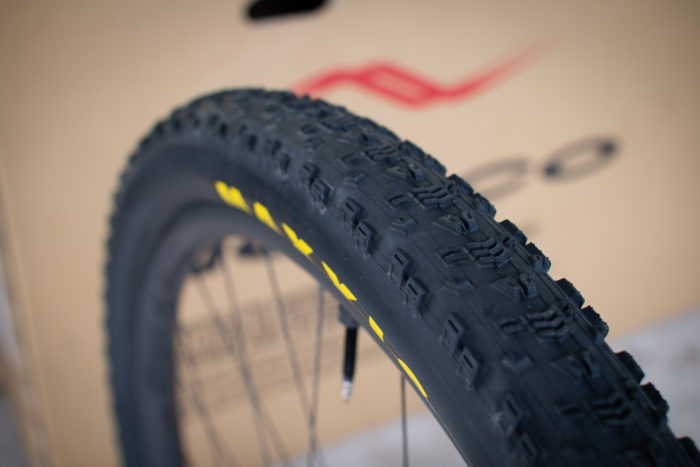Maxxis has recently announced two new additions to their range of cross-country tyres. Anyone who has kept a close eye on the World Cup circuit (ok, in 2019) won’t be overly surprised that Maxxis has released Wide Trail (WT) versions of the Aspen and Rekon Race, in 2.4″ widths.
The WT standard is optimised for rims that have a 30mm inner width, but they can work with rims that have a 25mm inner width. Much of the development was done with the Scott-SRAM Team, who use DT Swiss wheels. For a few seasons the likes of Nino Schurter and others have been using rims with a 30mm width. Florian Vogel started in 2017, and Jolanda Neff was also a fan of wider rims when racing with DT Swiss wheels.
“The improved traction from the WT XC tires helps control the bike in
difficult sections. I can ride at the limit while still being in control of my
bike.” – Nino Schurter
Once inflated, the Maxxis WT Aspen and Rekon Race in 29×2.4″ will measure about 61mm across, on a 30mm rim at 25psi. This is where it might be hard for lots of us to try it out, as you still need to have clearance, and Maxxis state that you should have 6mm (as a minimum) clearance around the tyre and your frame and fork.
Some bikes are compatible, but others won’t be.
That’s not to say that riders without one of those bikes can’t get the benefits of a wider tyre. Our team has been using Maxxis 2.35″ tyres like the Rekon Race and Ikon, and even the Maxxis Rekon 2.4, on 25.5mm and 29mm wide rims with lots of success. The measured tread is about 61mm for the Ikon 2.35″ on 29mm internal rims. The Rekon Race 2.35″ is just under 59mm on a 25.5mm rim. And an Aspen 2.25″ on a 30mm internal rim is already pretty wide…
Why go wider?
The mix of a wider rim and tyre creates greater volume, and with the right tyre pressure, better stability. You also end up with a greater overall circumference, which can help rolling ability on rough ground.
With the 29×2.4 WT Aspen claimed to weigh 720g, and the Rekon Race 760g, we’ll have to wait and see if these are the race tyres we have been waiting for. But if you’re not sure and want to try something now, then you are likely to get a very similar experience with a Maxxis 2.35″ model like the Ikon, Rekon Race or even the Ardent Race. If in doubt, check out our tyre comparison.
Pro riders like Schurter claim greater stability with the wide rims and 2.4″ WT tyres, and we agree. The difficulty comes in getting your tyre pressures right, as if you get them too low you still find that you can have a floppy feeling. Too high and the ride is too harsh.
Overall, when using 2.35″ tyres on 29mm rims we have found greater traction, even when using lower tread height models like the Rekon Race. The contact area is a lot larger than a narrower tyre on a 25mm internal rim, hence the greater traction. Anecdotally, the wide rim and tyre combination feels a little slower on sealed roads on the way to trails. But we don’t have any data to confirm that.
The 29×2.4″ Aspen may change that, although given how quickly it loses the edges of tread, it probably won’t be the best tyre to train lots on and expect it to hook up on race day.
When encountering fast and loose trails, wider tyre and rim combinations are a lot more sure-footed – and feel faster.
We hope to get a set of Aspen and Rekon Race WT tyres later this year to compare them to the rest of the range, and do some back to back testing with 2.25″ models on 25mm rims.

